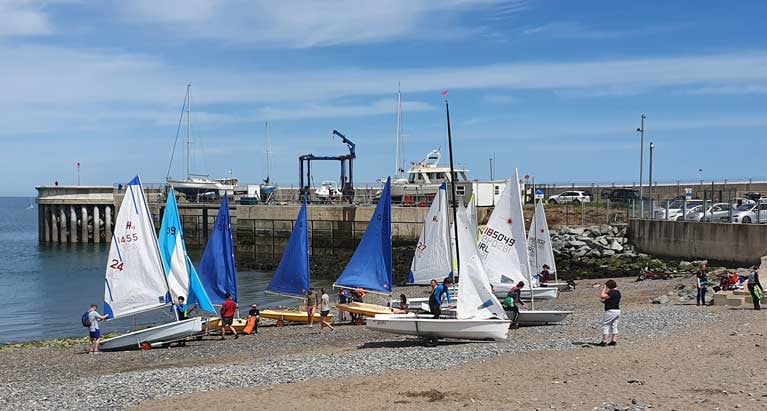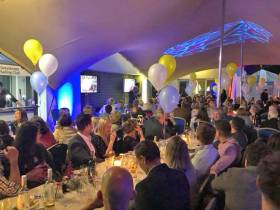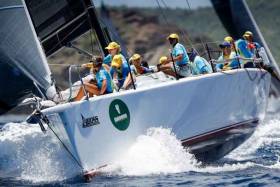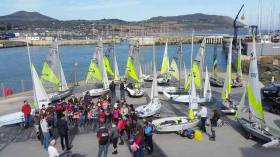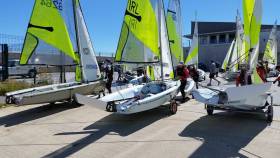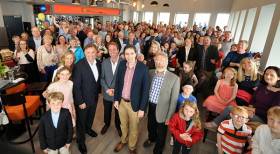Displaying items by tag: Greystones Sailing Club
The RS400 and RS200 Eastern championships were held at Greystones Harbour Sailing Club, and it was a thrilling day for the 24 RS 400s and other boats that participated. The Simon Herriot Memorial trophy was also incorporated into the event, adding an extra layer of significance to the competition.
The first race was marked by several lead changes between Galligan/Zack and the current national champions, Andy Verso and Tom Moran. Race two was intense as a strong gust of wind came in off the land pre-start. Rumball and Sam Hunt took first place in this race, making it their moment to shine.
In race three, Dara McDonagh and Trish Clancy claimed the victory, making it a different winner in each race. It all came down to the final race to decide the overall winner. Galligan and Zack tried to port tack the fleet off the start line but didn't quite pull it off. However, they managed to do some damage limitation and rounded the top mark first. After holding off the fleet, Galligan emerged as the winner and claimed the Eastern Trophy and the coveted Simon Herriot Memorial Trophy.
 Kenny Rumball and Sam Hunt were presented with second prize at the RS400 Eastern championships at Greystones Sailing Club by Commodore, Kieran O'Byrne
Kenny Rumball and Sam Hunt were presented with second prize at the RS400 Eastern championships at Greystones Sailing Club by Commodore, Kieran O'Byrne
 Andy Verso and Tom Moran were presented with third prize at the RS400 Eastern championships at Greystones Sailing Club by Commodore, Kieran O'Byrne
Andy Verso and Tom Moran were presented with third prize at the RS400 Eastern championships at Greystones Sailing Club by Commodore, Kieran O'Byrne
 The RS400 Masters winners were Canice Keane and Peter Dolan and were presented with their prize at the Eastern championships at Greystones Sailing Club by Commodore, Kieran O'Byrne
The RS400 Masters winners were Canice Keane and Peter Dolan and were presented with their prize at the Eastern championships at Greystones Sailing Club by Commodore, Kieran O'Byrne
GCSC's Alex and Martin Roe Crowned Champions at RS 200 Easterns
The RS 200 Easterns saw twelve top-class sailors take to the water, including seven junior and four lady helms. The event, held on a flat sea with gusty offshore breeze of up to 25 knots, saw the competition on the water get intense as a three-boat fleet from Greystones was joined by visiting boats from Galway Bay, Cullaun, Killaloe, and Wicklow.
Despite the gusts coming through the downwind causing many a capsize and flat-out hiking on the upwind, the pace of racing was electric. GCSC's son/father duo Alex and Martin Roe ultimately took home the top honours, with a 1st, 3rd, 2nd, and a final 1st in the fourth race.
Wicklow SC's Alex Costello and Charles Heather came in second place, with third place going to Greystones juniors - and twins - Cian and Caoimhe Swan. The RS200 fleet has been building over the last few years, with juniors feeding in from the Feva fleet.
PY Dinghy Sailors Brave Stiff Winds
The Greystones Sailing Club (GSC) held a sailing event last weekend, but unfortunately, none of the expected two-man boats showed up. The PY fleet, consisting of an Aero 6 and 11 ILCAs, sailed singlehandedly with 6 and 4-foot rigs. Despite the strong offshore winds and a forecast that may have deterred other sailors, the fleet launched after the beach master gave the signal.
The races were turned around quickly by the Race Officer (RO), Michael Conway, who had to abandon several races during the starting sequence and move the windward mark several times throughout the day. The wind fluctuated in strength, with the local keelboat fleet recording a gust of 28 knots at one stage.
 RS Aero sailor Roy Van Maanen receives his PY prize from Greystones Sailing Club Commodore, Kieran O'Byrne
RS Aero sailor Roy Van Maanen receives his PY prize from Greystones Sailing Club Commodore, Kieran O'Byrne
Several boats capsized, and one broke its mast during the races, but the sailors remained undaunted. The conditions favoured the Aero 6, sailed by Roy Van Maanen, who outperformed the ILCA 6's. Matthew Lawless, Donal Walsh, and Gareth Giles posed formidable challenges, with the lead positions changing constantly.
After an exhausting day of sailing, the fleet returned ashore to enjoy a BBQ and hospitality at the GSC.
All in all, it was a successful event that showcased the sailors' resilience and determination in the face of challenging conditions.
Following last year’s expansion to two days, the 2023 Taste of Greystones Regatta hosted by Greystones Sailing Club will once again be a weekend affair on 26-27 August.
As with the 2022 event, Saturday’s late single race will have a first start at 3.30 pm to allow clubs time to allow visiting keelboats plenty of time to get to Greystones Marina in Co Wicklow.
Two races are scheduled for Sunday morning, with the first gun at 10.55 am and the aim to have everybody off the water by 2.30 pm.
 Keelboats are invited to get a ‘Taste’ of racing off Greystones in this season closer on the weekend of 26-27 August
Keelboats are invited to get a ‘Taste’ of racing off Greystones in this season closer on the weekend of 26-27 August
Sponsored again by BJ Marine, the event continues to put a premium on hospitality with complimentary food on both days, plus beer vouchers for all crews.
“We can’t guarantee the wind conditions,” regatta director Daragh Cafferky says, “but we can guarantee a warm welcome.”
The NOR, entry form and boat registration links are now available on the club website GSC.ie.
‘Taste of Greystones’ Regatta Returns Next Month
Greystones Sailing Club has announced the return of the Taste of Greystones regatta on the weekend of 27-28 August.
A big change to the event this year will be racing on both the Saturday afternoon and Sunday morning, in an effort to avoid the risk of weather undermining everybody’s best efforts.
Saturday’s late single race will have a first start at 15.30 to allow clubs time to reach the East Coast club comfortably.
A big feature of the Taste of Greystones has always been the hospitality, and this is now further enhanced with the support of the Codling Wind Park as hospitality partner.
“The late Satuday race may not suit all the Dublin Bay boats fighting for championship points,” the club says, “but if the crystal is out of reach in Dublin Bay there is still plenty to be had in Greystones and the best social regatta you could treat the crew to.”
The NOR and entry link are now available on the club website GSC.ie.
Taking advantage of the glorious weather and the lifting of restrictions, Greystones Sailing Club launched a fleet of 37 dinghies last Saturday, and another 18 went out last night (Thursday). This was the second week of a race training programme organised by the club aimed at single handed and double-handed from the same household sailors.
The usual fleet of RS 400s, 200s and Fevas was boosted by an exploding fleet of Lasers recently added to the club, not to mention a number of adults who shoe-horned themselves into the clubs fleet of Laser Picos as the only option for sailing under the current Irish Sailing advisory.
 A fleet of RS 400s, 200s and Fevas was boosted by a new fleet of Lasers at Greystones Harbour
A fleet of RS 400s, 200s and Fevas was boosted by a new fleet of Lasers at Greystones Harbour
Managing what she described as “quite a logistical challenge” club Commodore, Daphne Hoolahan patrolled the beach ensuring that all participants were signed in and out to comply with contact tracing requirements. The fleet took part in a series of practice starts and sprint races.
 An RS Aero (right) is part of the dinghy scene under the Sugerloaf at Greystones Bay
An RS Aero (right) is part of the dinghy scene under the Sugerloaf at Greystones Bay
Coaching organiser, Fiachra Etchingham, was delighted with the outcome. “As Saturday progressed, you could see significant improvement in our sailors who’d had a longer than usual off season” he commented. “The current restrictions have compelled us to do something we do so little of, train for our sport!”
The training programme will continue in the coming weeks with North Sails Shane Hughes being lined up for a master class in due course.
#Greystones - Greystones Sailing Club celebrated 50 years of racing and adventures from the North Wicklow harbour at the recent ‘Big Barn Banquet’.
Members old and new gathered at the clubhouse compound on Saturday 16 June — including Irish Sailing president Jack Roy, whose father John co-founded the club in 1968.
Local TD and Health Minister Simon Harris was also in attendance among a veritable who’s-who of Greystones sailing.
The Greystones Guide has more on the story HERE.
#Greystones - Greystones Sailing Club has described the loss of junior member Laura Dempsey in a drowning incident in Crete as “a harrowing tragedy to happen on a family holiday”.
Dempsey, 15, was found unresponsive in her hotel pool by her parents on Sunday evening (25 June) when they became concerned for her whereabouts, as The Irish Times reports.
Tributes have come from around the community of the North Wicklow town for the popular teenager, who had recently completed her Junior Cert exams.
Greystones Sailing Club Commodore Daragh Cafferky said its members, which include the Dempsey family, have been left “devastated” by the tragedy.
“Laura had a very central role in our club and the loss of a child is deeply traumatic,” he told The Irish Times. “As a family they are a very pro-active family when it came to sports, in particular water sports, so out deepest condolences are with Nicki and John and the extended family at this dreadful time.”
The Irish Times has more on the story HERE.
Greystones Sailing Club and Lough Derg Yacht Club member Pamela Lee racing on TP52 'Conviction' as Bow at Antigua Race Week wrapped up class RSA3 in impressive style.
When we last reported, Conviction led with four wins from five races and she continued on that consistent tack taking seven wins from eight races overall.
It wasn't the only Irish success in Antiqua either. A Howth Yacht Club crew led by Ian McCormack on USA entry Porthmeor, Neil Styler's Oyster 49 were second in RSA nine.
The Grand Awards Ceremony for Antigua Sailing Week was held in Nelson's Dockyard and the UNESCO World Heritage Site was a fitting venue for the 50th edition of this historic occasion. Thousands of sailors attended the ceremony and whilst all of the respective class winners had been posted, there were special awards that were still to be announced, including the biggest prize in Caribbean sailing, the Lord Nelson Trophy.
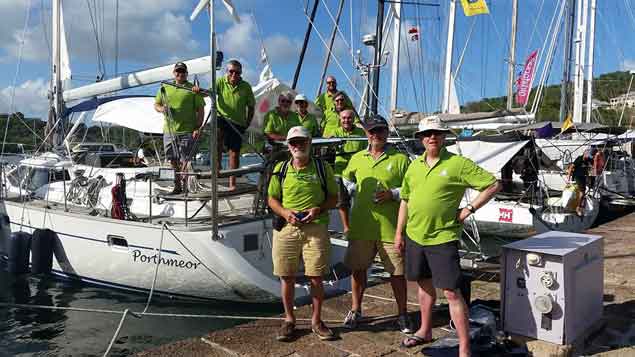 The Portmeor Oyster 49 crew including Howth sailors. Photo: Ian McCormack/Facebook
The Portmeor Oyster 49 crew including Howth sailors. Photo: Ian McCormack/Facebook
Asot A Michael, MP, Minister of Tourism, Economic Development, Investment & Energy of Antigua and Barbuda, gave a heart-warming welcome speech to the crowd, which highlighted how important Antigua Sailing Week is to the twin island nation. Guest of Honour, His Excellency Sir Rodney Williams, Governor General of Antigua & Barbuda presented the main prizes.
The stage was glittering with dozens of trophies, many of which have been sought after for decades of Caribbean racing. Winners took to the stage to receive their appreciation from the crowd, and finally there was just one trophy left. You could feel the tension as MC Tommy Paterson announced the winner of The Lord Nelson Trophy as Sergio Sagramoso's Puerto Rican Melges 32, Lazy Dog.
Sergio Sagramoso and his team took to the stage to tumultuous applause and then crowded around the historic Lord Nelson Trophy after the prize giving, scanning the list of names etched upon it over the years. The last Puerto Rican boat to win the trophy was Tom Hill's Titan XII in 2005.
"It is really amazing," smiled Sergio who had been racing in the highly competitive CSA 4. "I am so proud.
The Lazy Dog team will always remember this moment; this is why we do it. This was the toughest regatta I have ever been to with eight races and a very high level of competition.
Ross Applebey's Oyster 48, Scarlet Oyster had been in impressive form all week, however the British charter boat was once again just short of winning the Lord Nelson Trophy. Ross and his crew didn't leave empty handed though, as the team left the stage with a huge haul of silverware for their efforts including: The Governor General's Cup for first overall in CSA 5, Best British Race Charter Yacht, Royal Southern Yacht Club Shield Trophy for the Inter-Yacht Club Challenge and the Peter Deeth Trophy for 2nd overall in CSA 1-6.
Sir Peter Harrison's Super Maxi Sojana racing in CSA 1 was close to winning the Lord Nelson Trophy for the second time and the crew where in good spirits as they took to the stage to receive multiple awards. They broke into song, singing 'Happy Birthday' to both the regatta and Sir Peter who celebrated his 80th birthday during the week. Sojana's trophy haul included: the Curtain Bluff Trophy for the overall win in CSA 1, The Corum Cup for winning overall in CSA 1-6, and the Fletcher Trophy for Best British Yacht.
Fritz Bus's St. Maarten Melges 24, Team Island Water World had an epic battle in CSA 6 with Antigua National Sailing Academy's Cork 1720, Spirit, skippered by Jules Mitchell. Team Island Water World won the class and Best Caribbean Boat in Start Boat A. Spirit was the Best Antiguan Boat in Start Boat A. After a keenly contested duel it was great to see the two teams sharing a photograph at the Awards Ceremony.
The K3 Foundation, racing Kialoa III and Clint Brooks' Bajan TP52 Conviction had a fantastic regatta; both yachts scoring seven bullets to win their respective classes, CSA 2 and CSA 3.
Winning the Big Banana Trophy for Best Caribbean Yacht and the Grant Thornton Trophy for Best Boat Overall in CSA 7-9 was Cary Byerley and Sir Robbie Ferron's Micron 99 Lord Jim from St. Maarten. The team had to overcome a 1.5 point deficit in the last race to their long term rivals, Sir Bobby Velasquez and his St. Maarten team racing L'Esperance. They went on to achieve victory by just two seconds!
"Two seconds and half a point; shockingly dramatic," commented Sir Robbie Ferron. "I could never believe it would be that close. In all my years, I have never won a regatta like that and I doubt if anyone else has. For the last three years, I have been racing against Bobbie in many regattas and we have always just missed out. I have great respect for him so we have a great ambience. Reflecting on how Antigua Sailing Week had evolved, this regatta has done the right things for the competitors and it is getting the appropriate response. Sailors are enjoying the experience and that is why it has such a great turnout and I believe that the momentum will continue beyond the 50th regatta, continued Ferron."
Antiguan, Sir Hugh Bailey won the Lord Nelson Trophy last year and was second in CSA 3 this year with a new acquisition, his Farr 45 Rebel-B. Sir Hugh has been involved in all 50 editions of Antigua Sailing Week.
"Back when it all started, if you told me that 50 years on we would have thousands of people racing in Antigua from all over the world, I would have said that was far from our thinking. I am happy to see the growth and I feel privileged because I am the only captain from the early days still alive and on the race course. This year I really enjoyed my new boat Rebel-B; we have a lot to learn, and I am sure we will get the boat even faster."
Winning the Dream Yacht Charter Trophy and one week Bareboat charter from Antigua was Mike Cannon & Neil Harvey's KHS&S Contractors from Florida, USA. "The team has won multiple times all over the Caribbean, but this was its first trip as a team to Antigua Sailing Week.
"I cannot believe how good this experience has been," commented Mike Cannon. "The crew and the people in Antigua have been just fabulous - unreal. I am not sure why it has taken us so long to come here. I have been to a lot of regattas in my life and this is one of the best places I have ever been and you can be sure we will be coming back!"
Steve Carson's Dehler 33, High Tide won CSA 8 after seven years of trying.
The 51st edition of Antigua Sailing Week will take place from April 28th to May 4th, 2018.
17 Fevas For Greystones Sailing Club Coaching Session
17 RS Feva dinghies participated in the latest round of coaching for the class at Greystones Sailing Club at the weekend writes Garett Donnelly. Conditions were perfect with coaching provided for all the sailors ranging in age from 11 to 17 years of age.
Sailors from Greystones, RStGYC, RIYC, Bray SC, Malahide YC and Howth YC took part.
Next up on the Feva 2017 calendar is coaching in Malahide Yacht Club from 8th to 10th April and then Howth Yacht Club for coaching on 19,20,21.
The Eastern Championships follow on 22 and 23 April. Entry for the Easterns is here.
Welsh Crew Lead RS Feva Nationals at Greystones Sailing Club
A rejuvenated Irish RS Feva fleet mustered nearly 40 boats for its national championships at Greystones Sailing Club in County Wicklow today.
After three races in a blustery 18–knots, Welsh youth visitors Eddie and Kevin Farrell of Llandudno Sailing Club lead by a margin of three points having won the first two races.
Full results on the RS Feva facebook page here
Racing continues tomorrow.
Minister Simon Harris, officially opened Greystones Sailing Club's new premises on the South Pier in Greystones, County Wicklow this afternoon.
The Club, originally established in 1968, caters for over 350 members and is very much a family club, rooted in the Greystones community. Initially, sailing was confined to Mirror dinghies launched from a rubber mat rolled out on the shingle on North Beach with boats transported to and from the harbour on the tops of cars. The old clubhouse was built in the early 1970’s and has continued to be a part of the Greystones community since then. Now with the opening of the new facility, the club boasts over 100 dinghies and 20 keelboats and has one of the strongest junior sections of any club along the East Coast and is set to grow.
Speaking at the Official opening today, Commodore of Greystones Sailing Club, David Nixon said that “Greystones Sailing Club has moved to new, bigger and better facilities only a few hundred meters from where our club first began. We have moved, but our ethos of a family friendly, community based club still remains as strongly as it was when the club was first developed in the late 60’s. Our aim with our new facilities is to grow sailing in the community and the new clubhouse is the catalyst to drive that through our growing membership. We invite all Greystones families and anyone with an interest in sailing to contact us and see if sailing is for them. We are open for membership to anyone who thinks they might enjoy sailing. No experience is required and we now have a choice of sailing in dinghies and a growing fleet of keelboats who are often looking for crew, no matter how experienced they may be.”
Greystones Sailing Club prides itself as being part of the rich Greystones community and is aimed at family participation at all ages. Over the year's the club has had a huge growth in family membership with an increase of 40% this year compared to last. Greystones Sailing Club has the biggest junior section of any sailing club on the east coast with a programme each summer, that will train up to 200 children of all ages, throughout June, July and August this year. The thriving junior section has been a great lifeline for the club as it is through the junior’s, the club gets the rest of the family hooked – even the parents and adults who never thought they might like sailing, see what fun can be had and how exhilarating it can be.
David added that Greystones Sailing Club “offers any child and adult a sailing experience with our annual open “Try Sail” events where we invite anyone to come sailing and try it out to see if they like it. There is a great social side to the club too, with special food evenings and social events held regularly. We now also have a world class facility of Greystones Harbour Marina on our doorstep, which houses our growing keelboat fleet where 20 keelboats race twice weekly, compared to three years ago when we had just four boats. We are delighted to open our new fantastic facilities today and look forward to welcoming many more families and friends through our doors over the years to come.


























